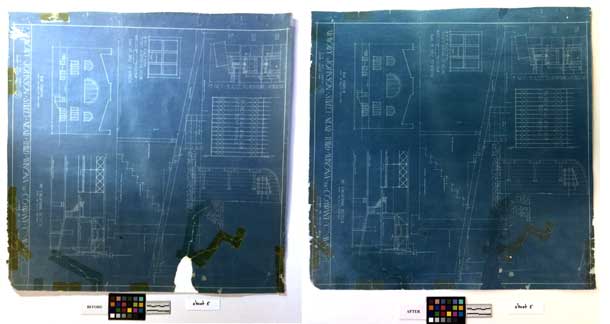Conservation of Blueprints for the National Guard Armory in Winona

The National Guard Armory building in Winona has been an essential space for the community and organization for over a century. For this reason, the blueprints were identified as a priority item in a previously awarded General Preservation Needs Assessment Survey & Long Range Conservation Plan for $6273. The Armory's original blueprints have four sheets produced by Hoffman & Mosse, Architects of Rochester, Minnesota, in August of 1914. What remains of the original Armory blueprints are sheets three through six of the plans. Sheet three shows the front and back facades, sheet four shows side elevations, sheet five shows the rear elevation, longitudinal section, structural details, and sheet six shows the roof design.
An artifact of great importance to the organization and community has been professionally conserved. The four blueprint sheets were cleaned, a great deal of pressure-sensitive tape was removed, tears were mended, and they have been rehoused. If not treated, the blueprints would have deteriorated until they became even more fragile and were no longer accessible. With this project completed, the blueprints will be preserved for future generations.
Visit https://www.mnhs.org/about/leadership
Visit https://www.mnhs.org/preservation/legacy-grants/advisory-committee
$4,500,000 the first year and $6,500,000 the second year are for history programs and projects operated or conducted by or through local, county, regional, or other historical or cultural organizations or for activities to preserve significant historic and cultural resources. Funds are to be distributed through a competitive grant process. The Minnesota Historical Society must administer these funds using established grant mechanisms, with assistance from the advisory committee created under Laws 2009, chapter 172, article 4, section 2, subdivision 4, paragraph (b), item (ii).
Available upon request. grants@mnhs.org
In our application we had one short-term expected impact:
- Blueprints are in a stable condition in an acid-free environment.
This was achieved during the course of the project, although we do not have them back at the History Center yet.
One intermediate-term expected impact:
- Images taken from blueprints will be more exhibit appropriate.
Now that the blueprints have been treated, we will be able to have them safely scanned and know that the reproduction will be the best image possible.
One long-term impact:
- The blueprints are accessible and in stable enough condition to be safely handled.
This will be true once the blueprints are back on-site, although once we have scanned them we hope to not have to handle them anymore.
Available upon request, grants@mnhs.org
